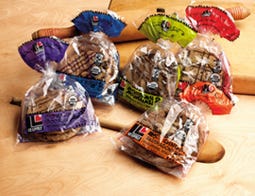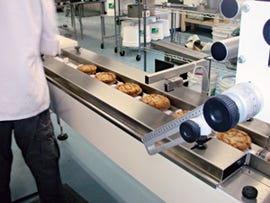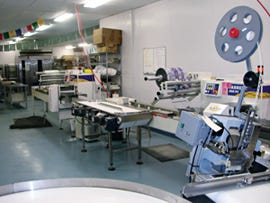Bagging machines boost speed for small, artisan baker
March 11, 2015

When the riptide started by the dot.com bust left Liz Holtz out of work, she sought solace in her first love: Sugar.
In a tiny kitchen in the Philadelphia attic apartment she shared with her husband Dan, Holtz began making chocolate truffles and chocolate-coated cookies for vegans like herself. She gave those chocolates and cookies to her intended end-consumers, who were her friends and family. Once friends and family had a taste of the cookies, they wouldn't stop asking Holtz when the next batch was coming. That's when Holtz decided to focus her new business on the cookies.
“My husband pushed me to go a lot further with it than I was planning to,” Holtz explains. Dan Holtz encouraged her to sell her cookies at retail outlets, specifically health food stores, and he supported her business with more than just words. Dan Holtz, a graphic designer, created the original company logo, which is a drawing of a little girl that brings to mind the rhyme, “Sugar and spice and everything nice, that's what little girls are made of.” Inspired by a former nickname, Holtz named her company Liz Lovely.
The cookies were packed in clear bags tied with a ribbon. The ribbon included a paper tag with simple black-and-white artwork consisting of serif and cursive type and a company logo. The cookie bags hit all of the right notes in the visual and olfactory departments. In an article titled, “Round 'Em Up, Head 'Em Out,” by Eric Hegedus of the Philadelphia Inquirer, Hegedus partly attributed his cookie addiction to Liz Lovely's packaging. “From the enticing whiff of walnuts (as the package is unsealed), to the layer of dark chocolate that coats the underside, these crunchy, four-inch rounds are a delight,” he stated in the newspaper's June 26, 2003, edition.
The original packaging also came with high costs in labor and time.
“I don't think if we knew what we were getting into that we would have done it,” she admits. Whole Foods Market is a major health food retailer; the company is so large that it claims to be the world's leading retailer of natural and organic foods. The Whole Foods Market near the Holtz apartment also was where the couple bought their groceries. They had built a rapport with the store's staff so the couple brought the cookies in for its opinion.

Cookies convey in pairs to the first pouching system, which envelopes them in a clear, inner wrap. They move single-file to the second machine, which bags them in a printed film.
“My husband and I were kind of naive,” Holtz recalls. “We knew there were seven Whole Foods in the area, and when we brought the cookies to one of the stores in the area, they really liked the cookies.” The store staff told the couple that the cookies would do well in the store, but they had to get Whole Food's regional representative on board. The Holtzes continued to build their relationships with the local store employees, and they eventually uncovered details about a corporate meeting on Whole Foods' bakery business.
“We knew they were going to have this bakery team leader meeting for that region,” Liz explains. “So, we woke up one morning and drove to the meeting at five o'clock in the morning with the cookies. We told them just enjoy the cookies. I thought maybe we'd get into the one store, but they called back and told us we were in seven stores, and then it became twenty-three stores.”
Growing pains
While their attic apartment in Philadelphia sufficed when the Holtzes first started the business, it was too small to bake cookies for 23 Whole Foods locations. The Holtzes needed a larger facility to fill all their new orders. They found the answer in a 38,000-sq-ft building in Waitsfield, VT, that offered space to grow and an idyllic setting, but it also came with its own challenges.
“Where we located, it's difficult to find people,” Holtz explains. “We're kind of a ski town in the mountains.” As of presstime, the Holtzes' commute to the new factory didn't include passing a single traffic light.
Holtz admits that she could have solved her labor problems by outsourcing her manufacturing, but that solution wouldn't have followed her artisan philosophy. “A lot of other companies don't do their own manufacturing anymore,” she explains. “One company might make six brands of products. There are six different recipes, but they are made by one factory.”
Holtz attributes the high quality of her cookies to the fact that each cookie is handled by “a real person, continually throughout the day.” The problem was the cookies also were hand-packed, which didn't enhance the quality of the product, but it did take away from the bottom line.
As recently as last year, Liz Lovely still was hand-packing its cookies. “There was a whole staff devoted to packaging,” Holtz explains. “Last year, we were spending five hours a day hand-packing the cookies. That's a lot of a labor and time.”
The amount of hand packing didn't correlate with the company's mission of providing interesting work with sustainable schedules. “We had these people who are trained as artisan bakers tying little bows,” Holtz explains. “It's a very boring job. Although we pay a living wage, it still has to be interesting work to motivate people.”
To cut down on the time, Liz Lovely's bakers were performing unskilled labor, the Holtzes turned to Ilapak (www.ilapak.com) sales manager Scot Chin. Specifically, the Holtzes wanted to ensure that their packaging would stay true to Liz Lovely's artisan spirit while respecting the company's business needs. “When Liz and Dan first came up to me, they wanted to have a package that wasn't an everyday-looking package and they also wanted to have the ability to elongate the cookies' shelf-life,” Chin recalls. “So, we came up with an idea that the cookies could be wrapped in an inner wrap, which has a total encompassing seal that locks in the freshness.”
For Liz Lovely, Ilapak designed two Carrera 500 PC horizontal form/fill/seal machines that create 80 pillow packs/min each. The first machine seals the cookies in a clear, biaxially oriented polypropylene, while the second machine places the cookies in open, fluted, printed BOPP bags. The printed outer wrap eliminates the need for ribbon and tags, and the wrap presented an opportunity for Liz Lovely to update its packaging design.
The Carrera 500 PC machine with rotary sealing jaws is engineered for speeds up to 100 packages/min, per jaw. It automatically adjusts the film-pull, infeed and sealing parameters during product or program changes, and the machine can hold 64 programs in its memory. Compatible with wrapping materials including heat- and cold-sealable films, the final deliverable machine can be customized for each operation's product, film and machine specifications, Ilapak notes.
Giving graphics a lift
Liz and Dan Holtz brought in a fresh perspective to redesign the company logo and its cookie packaging. “When we changed the packaging, we hired Lyn Severance from Harvey|Severance [www.harveyseverance.com], to design our new logo and look,” Hotlz explains. “She designed logos for Ben & Jerry's.”

The packaging line has greatly increased efficiencies and freshness of the now-double-wrapped cookies.
Severance's cookie packaging design was beautiful, and Dan Holtz added some finishing touches using his graphic design skills to adjust the logo and artwork so that it didn't completely cover the cookies. He also added the company's Organic and Fair Trade certifications.
The cookies are packed in pairs to help them weather the trip from factory to retail outlet. So the last piece of the design involved a Kwik Lok (www.kwiklok.com) bread clip closure at the end of the outer bag. “We just didn't want it to look like a regular grocery product,” Holtz recalls. “It's a fresh product, with a short shelf life, and it needs to look that way. Also, the bread lock allows a person to eat one cookie and put the other cookie back in.”
A paperboard insert could have been used to create the necessary rigidity in the package, but it would have hurt the package's design. “Our cookies are mostly coated in chocolate on the back,” Holtz explains. “With a paperboard insert, the chocolate wouldn't be seen.” The two-packs also encourage pass-along marketing, which Holtz describes as “sharing the love.”
Faster throughput
With the days of having four employees bagging cookies eight hours a day behind them, the Holtzes are better able to focus on their mission of creating “real” jobs. “The equipment actually made us a tighter operation,” Holtz explains. “We have two full-time employees. The equipment has increased our capacity maybe by fifty percent.” The savings allow the Holtzes to create a better work experience for these employees, and includes a steady salary and a schedule, along with a good work/life balance.
“We have a seasonal business,” Holtz continues. “In the summer and at the Christmas time, we don't sell a lot of cookies. I know many people think a lot of cookies are sold during Christmas, but that's not true. People make their own cookies during Christmas time.”
Holtz wanted to tell her employees to go home and enjoy the holidays with their families, but she also understood her hourly employees needed that steady income. “I felt they needed to stay because we were paying them hourly,” she recalls. “That's when I decided that we should start paying them by salary.
“People working here have real jobs,” Holtz declares. “They're on salary and they have a compressed work week.” The Holtzes plan to use their newly freed up capacity to expand their business and create a lot more of these jobs. “Our plan is to go national and build sales,” Liz explains. “We can get a lot more done in less time.”
More information is available: |
Ilapak, Inc., 215/579-2900. www.ilapak.com. |
Kwik Lok Corp., 800/688-5945. www.kwiklok.com. |
Lyn Severence, 802/660-1950. www.harveyseverance.com. |
About the Author(s)
You May Also Like


